GEAR
Recommended Gear for VR09/VR730
Dust covers
- Higly recommended: Gewa Economy keyboard cover (and similar brands):
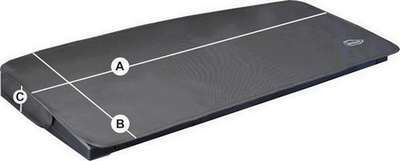
easy to put on (no fiddling with stretch), thick fabric protects against liquids and impacts. Available from (online)stores, amazon etc, ca. 13 €/$:
VR09: Gewa 275160 (102x40x6cm)
VR730: Gewa 275120 (122x44x6cm)
bargain: (identical) covers from ‘Music Steinbach’ Germany (7 €):
VR09: Steinbach Abdeckung (102 x 40 x 8 cm)
VR730: Steinbach Abdeckung (122 x 44 x 8 cm) - Rockbag (Warwick) dust covers:
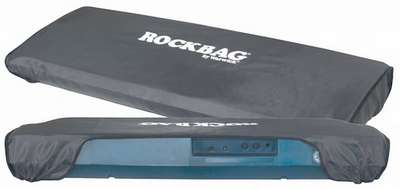
Nice (stretch) covers leaving the rear jacks free. Available from (online)stores, amazon etc. ca. 15 €/$
VR09: (too large)
VR730: RB21718B-122
Gig Bags for VR09
VR09/09B dimension are 101-30-11 cm. In the listing (inner dimensions in cm / padding in mm) is shown at each model name
- Gator G-PG 61 SLIM ‘THE BAG (103-33-14cm/30mm):
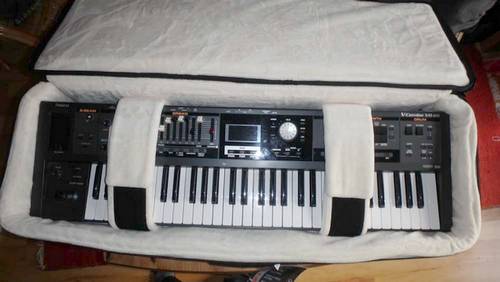
not cheap (watch out for offers, e.g. from gear4music), fits like a glove, best quality and best padding (30mm) on the market, semi-rigid (cannot be plied!), ca. 3 kilos - Gator GKB-61 SLIM (105-32-13cm/20mm) :
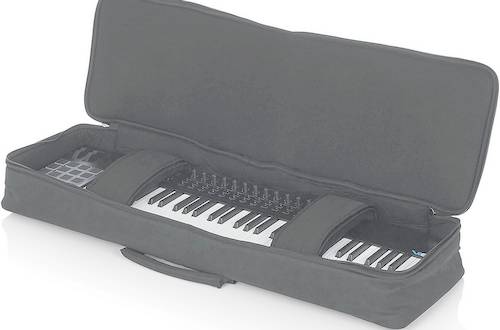
compared to G-PG: same perfect fit, half price, a bit lighter, less padding (20mm), flexible, no shoulder straps. Does the job very well./td> - MusicStore KCS-V (101-33-9cm/10mm)
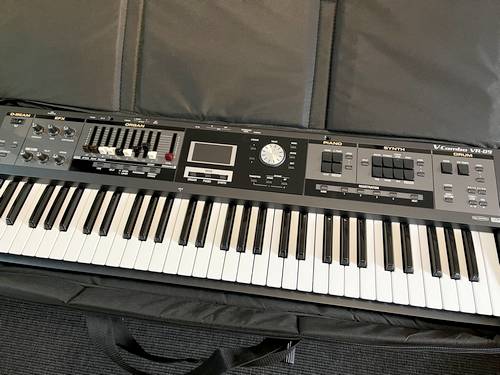
very decent’bugdet’ bag: 10-20mm padding, 2 pockets, good fit (verified, see pic). Sold by german/international MUSIC STORE (ca. 30 €)
Gig Bags for VR730
VR730 dimension are 122-37-12 cm. In the listing (inner dimensions in cm / padding in mm) is shown at each model name
- CNB KBB1600/76 (131-42-16cm/15mm): (from Mark B, UK) “good low cost gig bag, 15mm foam padding, the keyboard fits neatly inside & as it has backpack style straps it’s way more comfortable to carry than most bags. After a while the zipp did not close anymore”. Sold by smaller shops, prices vary from 50-100 €, actually (2023): ‘ToTheMaxx Music’ (Netherlands), ‘Music Direct Shop’ (Germany), ‘Musik Lenz’ (Austria), ‘Van Ginkel Muziek’ (Holland), etc
- Rockbag RB 21518 B “Deluxe” (122-42-16cm/15mm): simple transport bag, has inner fixing straps (ca. 55 €)
- Rockbag RB 21618 B “Premium” (122-42-16cm/25mm): enhanced version of 21518: + added padding + shoulder strap + more pouches (ca. 100 €)
- Rockbag LB 122: equal to RB 21518 on kytary store
- Rockbag RB 122: equal to RB 21618 on kytary store
- Kurzweil KB 76 (125-38-12 cm/30mm): “lite” soft Trolley, weights only 6kg (ca. 160 €)
- RockCase RC 21519 B (127-39-15cm/30mm): rigid Trolley, heavy (ca 10 kg) (ca. 130 €)
- RockVille 76 keys (129-46-16cm/30mm): rigid Trolley, heavy (ca 11 kg) (ca. 150 USD)
- STAGG KTC-128 (125-45-16cm/30mm): rigid Trolleybag with wooden support pannels, good fit (inner dimensions 125x42x13cm and can be adapted by included foam pads). Heavy (ca 10 kg). Very popular bag in Europe that can easly be found 2nd hand (new ca. 140-150 €)
Gun or Bow cases for VR09
For VR09 ‘tactical gun or rifle cases’ (or large bow-cases) can be used (verify inner dimensions!): they are sturdy, not as heavy has ‘professional hardcases’ and inexpensive.
Flight Cases
- Flyht Pro
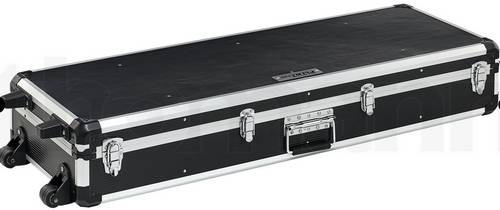
The version for “Juno-DS” perfectly fits VR09: a light 7 kilo (aluminium frame) ‘modern looking’ case with wheels for a bargain price of 105 € at Thomann - Thomann ‘Thon’ series
affordable flight cases ‘made-at-measure’ for VR09 and 730 can be ordered from Thomann Europe.
Options for the base packageo: coloured panels, wood or honeycomb plastic, trolley/wheels, ‘play-in-the-case’, ‘gear compartement’
(web-links” adapt language/currency, select manufacturer ‘Roland’ and model VR09 or VR730, chose options)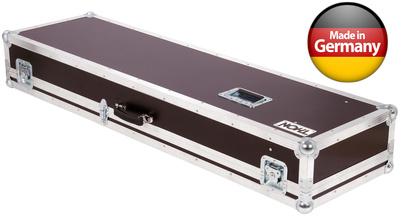
VR09 ‘Standard’: wood 9kg/165€, plastic 7kg/180€ (2021: 130/145€)
VR09 ‘Special’: wood 10kg/190€, plastic 8kg/200€ (2021: 150/160€)
VR730 ‘Standard’: wood 13kg/175€, plastic 10kg/190€ (2021: 140/155€)
VR730 ‘Special’: wood 14kg/225€, plastic 11kg/240€ (2021: 185/200€)
‘Special’ version is reeinforced and has self-lockable fastenings as shown in the pic.
Info: for ‘historical reasons’ the table also shows 2021 prices – welcome 2022… - Musicstore ‘BOXPROFI RS’
affordable flight cases ‘made-at-measure’ for VR09 and 730 can be ordered from Musicstore Germany:
VR09 RS Case: wood (150€)
VR730 RS Case: wood (170€)
Music rests
- VR09:
VR09 (VR09B) has 2 holes in the housing for plugging a music rest into: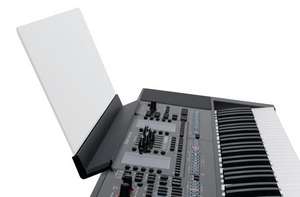
Roland plexiglas stand for BK5 / E-A7 keyboards fits (Roland No. 7782807000 ca. 90 USD/Euros, Aliexpress: ca. 60 USD). 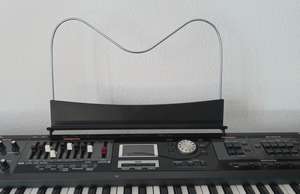
Music stand for Thomann SP 320 (cheap, light) fits plug&play (ca 10 USD/Euros): www.thomann.de/de/thomann_music_stand_for_sp_320.htm - VR730:
VR730 does NOT have any mounting system for a music rest. Either you modify the chassis or you place e.g. an ‘orchestral music stand’ behind the VR.
‘orchestra music stand’: cheap stands (ca. 15 €/$) are currently available anywhere. They are sufficently robust for using with a stationary keyboard setup
Damper (sustain) pedals & foot switches (Leslie)
VR09/730 can be used with a ‘switch type’ damper pedal or a so called ‘halfdamper’ pedal:
- ‘switch-type’ pedals (piano-pedals or foot switches) toggle ‘abruptely’ between no and full sustain
switch-pedals are available at 10 $/€ upwards - ‘halfdamper’ pedals have a ‘soft transition’ between no and full sustain length and allow to hold different the sustain lengths depending how far the pedal is pressed. This behaviour corresponds to ‘real pianos’
|
Using a halfdamper pedal, for adding ‘just a bit of sustain’ and a smoother transition between no/full sustain, significantly improves the mediocre acoustic pianos of VR. Therefore the recommendation for VR09/730 is the Roland DP10 (DP8): for a moderate price it has a lot of qualities: halfdamper, robustness, ‘anti slip rubber flap’ (DP10), adjustable spring preload, ‘switch’ and ‘half-damper’-mode. |
Notes:
* ‘switch-pedals’ for VR must be of type “momentary (unlatched)” + “opener” (contact opens on pedal press)
* it’s recommended to buy pedals with selectable polarity (allowing usage with other keyboard makes)
* slim ‘foot switches’ (from ze monde of guitarre) are easy to transport while
‘piano style pedals’ give a better ‘piano-like’ feel/feedback
* if VR is used as top key on a multi-tier stand, attention must be payed to ‘cable lenght’.
Pedals with long cables are Roland DP10 (2.2m) and Lead LDF1 (3m)
Examples for ‘footswitch’ and ‘piano-style’ pedals (prices in EU 2026):
| Pedal | price | style | polarity | notes |
| BOSS FS5U | 40 € | footsw. | selectable | Full metal ‘all time classics’. multiple FS5 can be attached to a pedal array |
| Thomann Lead Foot LFD1 |
9 € | footswitch | selectable | The “9 €” copy of Boss: light, minimalistic and surprisingly sturdy |
| Zoom FS01 | 30 € | footswitch | opener | ultraflat, full metal, precise action (the ideal ‘travel-pedal’) |
| Fatar FVP1-10 Fatar FVP1-25 |
20 € 25 € |
piano | opener selectable |
an ‘all time classics’ |
| Music-Store TB-1A | 13 € | piano | selectable | supercheap but reliable (tested by author). Probaly the lightes ‘real piano pedal’. The ‘open bottom structure’ grips into carpets preventing slip. Identical: Classic Cantabile FP-1, chinese ‘originals’ from aliexpress&al |
| Roland DP10 | 45 € | piano | opener halfdamper |
heavy, anti-slip ‘rubber foot plate’, half-damper, compatible to VR |
| Yamaha FC3, FC4A | 80 € | piano | closer | robust pedal, polarity of TS plug must be adapted to Roland/VR. For the Yamaha fans willing to pay the price |
| Yamaha FC3A | 80 € | piano | halfdamper | robust pedal, polarity of TRS plug must be adapted to Roland/VR. For the Yamaha fans willing to pay the price |
| others | < 20 € | piano | selectable | other pedals in the sub-20€ range: Miditech MP-1, Nektar NP-2, M-Audio SP-2, |
See also chapter Midi foot ‘super controllers’ below.
Expression pedals
Note: VR has a ‘expression pedal bug’: no commercially available expression pedal (with exception of Doepfer FP5) is correctly detected by VR
The bug and possible workarounds are explained on this websites
‘Swell’ versus ‘short travel’ (guitar) pedals
A real ‘organ expression‘ pedal or ‘Swell’ should at least have 8 cm of ‘physical throw’ (min-max measured at pedal ‘toe’ side).
Swell pedals are big and heavy, for stage use you might prefer a light ‘short throw’ pedal, which is also easier to control in ‘standing position’
Reduced ‘effective travel’ by ‘VR expression pedal bug’
Due to the VR expression pedal bug, ANY commercially available pedal has a ‘reduced effective travel’ : VR max volume is reached at mid position of the pedal: from mid to max position the volume remains constant.
To regain ‘full effective’ travel the pedal can be
– modified : Expression Pedal Mod
– converted to MIDI: Expression Pedal Guide
| Pedal type | examples | effective travel ‘out of the box’ |
effective travel ‘fixed’ |
remarks |
| Compact ‘short throw’ |
Roland EV5, M-Audio EX-P, Nektar | 1cm | 2-2.5cm | un-fixed pedal reacts like on-off switch |
| Organ swell ‘long throw’ |
Behringer FCV 100, Yamaha FC7 | 3-4 cm | 6-8cm |
Pedal models
* Simple build ‘short throw’ pedals
| Pedal | price (EU) | polarity switch | volume offset | VR bug | remarks |
| M-Audio EX-P | 17 € | + | + | yes | very light, all plastic with metal base plate |
| Bespeco VM18L | 20 € | + | – | yes | all plastic with metal base plate |
| Bespeco VM19L | 25 € | + | + | yes | all plastic with metal base plate |
| Nektar NX-P | 22 € | + | + | yes | identical to M-Audio but different ‘foot plate’ |
| Roland EV5 | 65 € | – (fits VR) | + | yes | all plastic with metal base plate, overpriced |
| Line6 EX1 | 70 € | + | – | yes | all plastic with metal base plate, overpriced |
* Quality build ‘short throw’ pedals.
| Pedal | price (EU) | polarity switch | volume offset | VR bug | remarks |
| Behringer FC600 V2 | 65 € | + | + | yes | full metall, heavy, ‘pedal pressure’ adjuster |
| Moog EP-3 | 50 € | + | – | yes | reinforced plastic casing |
| Boss FV-500L | 100 € | + | – | yes | full metall, heavy, ‘pedal pressure’ adjuster |
| Boss EV-30 | 100 € | + | + | yes | DUAL expression controller (e.g. for 2 keyboards) |
* ‘medium throw’ pedals: note that the Doepfer FP5 is the ONLY pedal that compensates VR expresson pedal bug
| Pedal | price (EU) | polarity switch | volume offset | VR bug | remarks |
| Doepfer FP5 | 80 € | + | – | NO | sturdy, HUGE, polarity must be inverted |
* ‘Long throw’ pedals:
| Pedal | price (EU) | polarity switch | volume offset | VR bug | remarks |
| Behringer FCV100 | 25€ | – | + | yes | Plastic but sturdy, heavy. Works as stereo-volume pedal OR (passive) expression pedal. For VR, TRS polarity must be ‘modded’ |
| Behringer FCV100 V2 | 40€ | + | + | yes | like ‘Mk1’ but with polarity switch |
| StudioLogic FP/50 | 70€ | + | + | yes | Plastic but sturdy, heavy, For VR, TRS polarity must be ‘modded’ |
| Yamaha FC-7 | 90€ | – | – | yes | Plastic but sturdy. Spring for working point adjustment, brace-system for ‘arraying’ pedals. For VR, TRS polarity must be ‘modded’ |
| Roland EV-7 | >200-300 € | – | + | yes | Available only 2nd hand, very rare |
‘Check the prizce”
The popular ‘simple build short throw pedals’ are, with regard to construction materials, electric components etc, nearly idendical.
In a real life economics, these pedals are all ‘china budget production’ and just rebranded
The supercheap M-Audio is as good as the 3xpriced Roland EV5 or Line6
Just compare (from left to right):
Roland EV5: 65 € — Line6 EX-1: 70 € — Bespeco VM18L: 20 € 😀

Midi Expression pedals
Examples of midi expression pedal are:
- Beat Bars EX3 (ca. 170 €)
- Boss EV-1 WL (ca. 170 €)
- Prostage XCC (ca. 140 &euros;)
- Behringer FCB 1010: complete midi foot controller board with 2 (assignable) pedals. See chapter below ‘Midi foot super controllers’
- Roland – FC-300: like the Behringer. See chapter below ‘Midi foot super controllers’
- Roland – FC-200: old version of FC200, only 1 pedal
- Microdesignum MIDI Expressione 1A1F (discontinued, eventually in EU 2nd hand)
- Microdesignum MIDI Expressione 1F (discontinued, eventually in EU 2nd hand)
Expression Pedal-to-Midi Converters
Examples of converters for your analog pedal (e.g. to fix ‘VR expression pedal bug’).
The Converters come with an ‘app’ (Windows and Mac only!) for configuring the midi message types (e.g. ‘Control Change 11’ for expression).
- DoreMidi Pedal Converter MPC-10 (ca. 60 € ca. 40 when ordered directly from China) best-buy recommendation if you’re looking for an easy and cost-efficient ‘VR expresson-bug workaround’ : inexpensive and the ‘app’ is super-simple and self-explaining. Can send up to 16 different CCs per ‘pedal’ (note that it has a ‘midi-TRS’ type jack but a ‘TRS to 5-pin’ adapter is included)
- Midi Solutions Pedal Converter (ca. 150 €) : overpriced for what it offers (yes it can do ‘sysex’ but no Roland sysex-checksum which makes it quite useless for VR). The ‘app’ is a bit ‘oldschool’ and unhandy to use.
- Beatbars EX2M’ (ca. 60-70 € – discontinued)
Volume pedals
Examples of (stereo) volume pedals are. Note that the pedal has to be qulalified as ‘low impedance’ (often marked by letter ‘L’).
- Bespeco VM14L : a ‘budget’ short travel pedal. Volume offset knob. Solid built
- Boss FV-500L ‘dual use’: a short travel pedal than can run as stereo volume or expression pedal. Volume offset knob. Metal body
- Behringer FCV 100 ‘dual use’: a ‘budget’ long travel (swell) pedal than can run as stereo volume or expression pedal. Heavy. Execellent ‘feel’. Volume offset knob. Volume-mode adds a bit of white noise, which can be an issue for ‘recording’ but is absolutely negligable on stage
Bass pedals
VR09/730 work with ANY MIDI BASS PEDAL (including the Roland ‘PK’ series).
To connect a midi bass pedal, one can use either VR MIDI-IN or PK-IN (which is compatible to 5-pin midi plugs !)
By ‘VR default’, bass pedals play the VR organ bass. With the help of ‘CTRLR EDITOR’ any VR sound can be used for pedal bass
For details (midi connection, using ‘PK features’, etc.) please read chapter “Connecting a MIDI BASS PEDAL to the VR”
Roland models PK-5, PK-6, PK-7, PK-9 and PK-25 are ‘integrated plug&play’ units for VR-organs (unfortunately discontinued => buy 2nd hand), but any other midi pedal does work. Interesting units come from Studiologic (Fatar): light, sturdy, and flexible.
Roland PK-pedals have some advantages:
a. PKs are powered via VR “PK-IN” socket (no need for power-supply or batteries)
b. VR in organ mode ‘detects’ PK-pedal and the display shows upper, lower AND bass drawbars for adjustment
Setting bass drawbars with non-Roland pedals is more cumbersome:
set VR to ‘(left hand) bass split’, adjust bass drawbars, return to ‘normal split’
notes: approx. prices in EU 2020, “vel” : velocity sentitive pedals (velocity is not recognized at PK-IN)
| Pedal | price (€) |
notes | vel | weight (kg) |
description |
| Roland PK-7/PK-7A |
— | 20 | – | 13 | ‘complete’ bass pedal unit: 20 notes pedals, expression pedal, sustain switch, 2 lateral ‘pedal-switches’ for PK-controls. If connected to PK-IN socket it runs instantaniously, including PK footswitch options’ and ‘power supply’. 7A is slightly improved over 7. Discontinued / only 2nd hand |
| Roland PK-9 |
— | 20 | – | 13 | enhanced version of PK7: 20 notes pedals, expression pedal, sustain switch, 2 lateral ‘pedal-switches’ for PK-controls, 2 ‘free control switches’. If connected to PK-IN socket it runs instantaniously, including PK footswitch options’ and ‘power supply’. Discontinued / only 2nd hand |
| Roland PK-25/PK-25A |
— | 25 | ? | 30 | ‘full pedal’ unit: 25 notes pedals, expression pedal, sustain switch, 2 lateral ‘pedal-switches’ for PK-controls. If connected to PK-IN socket it runs instantaniously, including PK footswitch options’ and ‘power supply’. 25A is slightly improved over 25. Discontinued / only 2nd hand |
| Roland PK-5/PK-6 |
— | 13 | – | 8 | 13 notes, programmable foot switches. Discontinued / only 2nd hand |
| ELKA DMP 18 |
— | 18 | + | ? | A vintage ‘all times classics’: 18 notes, velocity sensitive pedals, foot switches send Program-Changes (useless on VR). Tasteful variant with white pedals. ‘Ageing’ has to be considered (30years+) |
| Studiologic MP113/ MP117 |
450-500 | 13 17 |
+ | 6 7 |
13 or 17 notes, velocity sensitive, can send control changes |
| Crumar MojoPedals |
500 | 20 | + | 9 | 13 notes, velocity sensitive, can send control changes |
| Ketron K8 | 400 | 20 | + | ? | 13 notes, velocity sensitive, no switches |
| Hammond XPK 100/200 | 700 1200 |
13 25 |
– | 9 13 |
13 or 20 notes pedal board with expression pedal |
| Nord Pedal Keys 27 | 2000 | 27 | – | 16 | 27 notes bass with expression pedal. Fixed midi channel 3 (works only with VR PK-IN) |
| Viscount Legend 18/25 |
1250 1500 | 18 25 |
– | 11 14 |
18 or 25 notes ‘full pedal bass’ with expression pedal and 1 footswitch (to TRS/TS plugs). Fixed midi channel 3 (works only with VR PK-IN socket) |
| Doepfer MBP25 ‘kit’ |
350 500 |
13 25 |
– | ? | DIY kit for 1 or 2 octaves: includes midi electronics, cabeling and 1 (13 notes) or 2 (25 notes) Fatar pedal units (not the sturdiest). The kit can be mounted into a selfmade case or ‘split case’ for easy transport. (note: due to new Fatar tarifs in 2025 prices have doubled from formerly 160/250 € to 350/500) |
| DIY ‘midifying’ | — | n.n. | – | ? | DIY “midifying” an ‘analog’ pedal unit is not complicated. Ebay provides us with (old) ‘analog’ pedal boards in all sizes. The easiest way is to ‘butcher’ a cheap used 25 or 32 key midi controller (ebay, 10-20 $/€), extract the circuit boards and connect the pedal contacts to the ‘contact board’. Using Arduino is also inexpensive (~ 20 USD/€). Doepfer MBP25 controller also works (up to 37 pedals) |
Midi foot ‘super controllers’
These midi boards offer (midi) expression pedals and switches and even ‘analog relais switches’. The pedals can be used for expression or/and for controlling any midi parameter of the key (e.g. pitch, filter-sweeps etc).
The Foot switches can also send ‘notes’ , on VR it can be used as “10 note midi bass pedal’.
- Behringer FCB 1010: a “guitar world classics” : midi foot controller board with 2 expression pedals, footswitches and even 2 ‘analog switches’ (e.g. for switching a real Leslie). Pedals and switches can be programmed onboard or via editor to send multiple Control Changes, Program Changes, Pitch etc (no sysex). Available new or 2nd hand for 50-70 ‘bucks’
Note that 2nd hand units are often modded with “UnO” (UnO-1) or “Kemper” chips (for UnO2 see below!): these are ‘guitar stomp box’ simulations which are useless for keyboards (and only increase 2nd hand price) - Behringer FCB 1010 + UnO2 ‘chip’: the UnO2 ‘chip’ (ca. 50 €) adds full programmability by writing entire “programs” for sending control changes, sysex-strings etc. The ‘free programming’ opens unlimited possibilities to control VR, e.g. simultaneously changing multiple ‘VR parameters’ with one foot switch or pedal. The “coding” requires basic mathematical understanding.
- Roland – FC-300: like the Behringer but in Roland spec (and price ;)). Can send Roland sysex to control every VR parameter, no ‘editor
- Roland – FC-200: old version, only 1 pedal, no ‘editor’

Rotary/Overdrive pedals for VR organ
Some pedals on the market:
– NEO Instruments Ventilator II/mini Vent II: THE reference, but very expensive (start thinking of buying a Nord Electro or SK1 instead …)
– Electro Harmonix Lester G/Lester K
– Nux Roctary (inexpensive, nice sounding)
USB-sticks (pen drives or thumb drives): buying, formatting etc
An usb-pendrive is used for firmware upgrades, backup ‘registration sets’, record or play mp3/wav files, record or play midi files (e.g. midi backing tracks) etc.
Recommended:
Low-performance USB-2.0 stick at maximum 32 GB (realisticly 1 GB is enough for VR, even with audio files)
Usb-3.x is ‘wasted money’ (no speed advantage in VR and may cause compatibility problems)
Examples:
VR09: ‘Intenso Rainbow’ 8GB ‘green’: cheap, solid, with LED that shines throught usb compartment showing if inserted or missing
VR730: because of the ‘rear position’ of usb-socket any ‘conventional’ produding usb-stick is prone to damage the socket. Use a flat’micro usb drive’ like ‘INTENSO Micro Line USB-Stick 8 GB’
- Formatting the usb-drive:
VR requires old fashionnedformat ‘FAT 32’:
– any freshly purchased ‘low-spec’ usb drive (usb-2.0/max 32GB) will work without formatting.
– if the sticks needs to be formated, this can be done on any PC/Mac (use FAT32 format) or on VR - Formatting the usb-drive in VR:
- turn VR on
- plug the usb-drive into your VR (VR09: left usb-compartement / VR730: usb-socket at rear side)
- Open VR menu: dial down to “Media Utility” and select (ENTER)
- In “Media Utility”, step down to “Format USB” and confirm
- VR Display will show “Executing” while formatting
- VR Display will clear when formatting is finished
Power supply (replacement and PowerPack adapters)
VR09 / V730 do work with ‘standard’ 9V supplies (for e.g. FX pedals) available from your local music store, online-store, Amazon, ebay, etc, with the following specs:
– 9V DC
– minimum 500 mA (tested value)
– 5.5mm/2.1mm ‘centre-negative’ plug
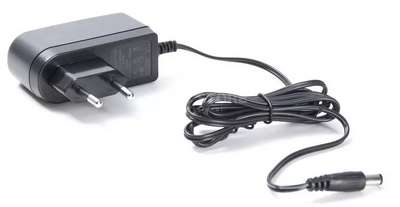 |
9V/500mA ‘FX supply’ from german MusicStore (7.50 €) |
An alternative to a ‘wart’ is to power the board from USB (great idea from David Webster!) with a Ripcord USB to DC power cable AA927MS (9V centre negative). NOTE: it has been reportet that the Ripcord and VR do not work with usb-powerpacks (even not the Ripcords) – it’s only for usb-chargers
 |
potentially a much neater solution than dragging a transformer around In the UK available from https://myvolts.co.uk |
To power VR from a USB-PowerPack (instead of AA batteries) or a USB-charger you can use a USB-to-9V transformer like the ENGL (just take care it’s delivered with a 2.1mm ‘center negative’ cable/plug)
 |
“ENGL Powertap Portable” supplying VR from a powerbank (available e.g. from Thomann, ca 15 euros) |
Wlan (wifi) transmitter for iPad
Connecting VR ‘wirelessly’ to an iPad with ‘Roland Editor app’ requires a wlan tranmitter (wifi dongle)
The ‘official Roland dongle’ (a rebranded Netgear dongle) is out of stock, but any dongle based on the ‘Qualcom Atheros AR9271’ chipset works with VR. Tip: ‘clever people’ are selling those dongles as ‘Roland replacement’ on ebay for 2-4x the normal price – which is ca. 10 $/€. Compatible dongles:
Netgear WNA 1100 (out of stock)
Roland WNA 1100-RL (overpriced branded Netgear WNA, out of stock)
Onkyo UWF-1 (overpriced, out of stock)
TP-LINK TL-WN721N
TP-LINK TL-WN422G v2
TP-LINK TL-WN722N
D-Link DWA-126
Unex DNUA-93
Amplifiers, Speakers and Monitors recommended for VR
See Amps & Monitors
Stage pianos recommended for VR
See Stage Pianos(for a list scroll down to ‘Buyers Guide’)
Hardware controllers & master keyboards recommended for VR
To trigger only keys you can use any controller. Many parameters can be changed by standard Control Changes (e.g. vibrato, pitch, ARD, filter etc), ‘deeper’ VR parameters (like drawbars, organ perc and V/C etc) can only be changed by midi system exclusive (sysex) messages.
The number of hardware controllers able to handle sysex messages with the Roland checksum is limited:
Midi Controllers without keys but Roland-SysEx:
Available (2023) on market:
– Behringer is working on BCR32 (a modern BCR2000) which might be released in 2025
Discontinued (available 2nd hand):
– Novation ZeRO SL MK1 (2007) : 8 pots, 8 faders, usb, windows editor
– Novation ZeRO SL MK2 (2009) : 8 endless encoder pots, 8 faders, usb, Windows editor
– Behringer BCF2000 (2011): 8 pots, 8 motor(!)faders, usb, Win/Mac editor
– Behringer BCR2000 (2011): 24 pots, 20 buttons, faders, usb, Win/Mac editor
– CME Bitstream 3X (200?): many pots, 8 faders, Roland checksum with firmware 1.8
– Kenton Control Freak / Studio /Live (1998-2001), 8 or 16 faders, 8 buttons, no usb, Win/Mac editor
– Doepfer Drehbank (200?): 64 pots, only pots, complicated programming
Notes:
Newer Novation SL Mk3 and higher DO NOT HANDLE SYSEX !
Behringer BCF/BCR are one of the most versatile controllers ever built and 2nd hand units are pricy. Freeware ‘BC Manager’ (MountainUtilities, Windows/OSX) can be used to program them, eg. defining the Roland checksum formula
Novation ZeROs are also very flexible in programming.
Midi Keyboards with Roland-SysEx: (see Midi Controllers chapter (A) for controller details)
Available (2023) on market: –
Discontinued (available 2nd hand):
– Roland A-Pro A300/A500/A800: 32/49/61 keys (keybed as VR09)
– Roland-Edirol PCR 300/500/800 (2007): 32/49/61 keys (light synth keys)
– Roland-Edirol PCR M30/M50/M80 (2005): 32/49/61 keys (light synth keys)
– Roland-Edirol PCR 30/50/80 (2002): 32/49/61 keys (light synth keys)
– Novation Remote SL Mk2 25/49/61 (2009): 25/49/61 keys (semiweighted Fatar TP/9 action)
– Novation Remote SL (Mk1) 25/37/61 (2007): 25/37/61 keys (semiweighted Fatar TP/9 action)
– Novation Remote SL COMPACT 25/49 (2007): 25/49 keys (semiweighted Fatar TP/9 action)
these controllers know sysex but not Roland checksum:
– Novation Remote 25/49/61 (2003): 25/49/61 semiweighted Fatar TP/9, AT, 8 pots, 8 faders, 8 pads
– Novation Audio/X-Staion 25 (2003): 25 semiweighted Fatar TP/9, AT, 8 pots, 8 faders, 8 pads
Midi Keyboards without SysEx:
Midi controllers without ‘Roland sysex’ can be used for playing VR (e.g. as lower organ manual), changing ‘standard Control-Changes’, playing VR GM2-sounds etc.
See Midi Controllers chapter (B) for standard sized keys
See Midi Controllers chapter (C) for ‘mini-keys’